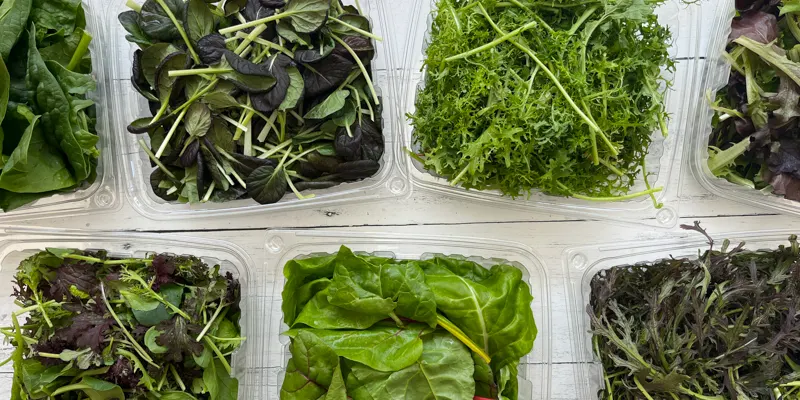
Creating a more sustainable food system
Our food system generates a lot of trash, carbon and food waste. Many grocery delivery companies are some of the biggest offenders. We combat these issues by prioritizing growers using regenerative agriculture methods, decreasing carbon emission throughout our supply chain, using reusable packaging, and making sure no food ends in a landfill. Read more about some of the specifics below.

Sustainable Packaging
Minimal packaging
Cauliflower wrapped in plastic? Weird. To cut down on needless bags and containers, we don’t package large fruits and vegetables that don’t need them. We also use paper to package whenever possible. We have had to build internal systems as well as work with farmers to make this possible.
Here is how we do it:
- Train staff to assemble the boxes to keep tender items protected in transit so they don’t require additional packaging
- Create an item labeling system to denote the different items packed in paper bags
- Refrigerated trucks so each box does not have to be insulated
Reusing boxes and other packing materials
Unlike most other grocery delivery companies, we offer customers the option of returning packaging when we drop off new orders.
These items include:
- Wax-coated boxes
- Ice packs
- Post-consumer recycled plastic clamshells for our baby greens
- Glass milk bottles
- Fishtown Pickle Project jars
After we process them for damage and contamination, these materials are reused for the next week’s orders, reducing the amount of trash left in customers’ bins.
Using 99% recyclable packing materials
We have worked extensively with our packaging supplier to identify post-consumer recycled packaging and find replacements for single-use packaging.
This includes:
- Paper bags for storage crops
- Thick paper packaging to support fragile products in boxes
- Paper pulp quart containers for fragile fruit
- Uncoated butcher paper for fragile tomatoes
All of these items can be recycled in your municipalities or repurposed. We encourage you to do so!
Reducing food waste in landfills
Selling mildly damaged and “ugly” produce at a discount
Rather than composting fruits and vegetables that have minor bruises or dings or are nearing over-ripeness, we offer them in our market as “seconds” priced at a bulk discount. (They're still delicious but meant to be processed right away.) Similarly, if the produce our farmers harvest is oddly shaped or has an unappealing appearance, we take those items at a slightly lower price and pass the savings to our customers in the market. We also see this as a way to teach people in our community that nutritious, sustainably grown local produce comes in all shapes and sizes.
Composting
Anything that is not edible is stored in our compost bins throughout the week. The following week when we pick up produce at our partner farms we back haul this food waste to their farms so that it can be turned into compost and used to grow more food. It really is a closed loop!
Reducing carbon emissions in our supply chain
100% renewable energy
our warehouse is powered by 100% renewable energy. We are also planning on installing solar panels on our roof!
Efficient delivery routes
We limit the delivery days and delivery times we go to each neighborhood so that way we can consolidate our deliveries by area and decrease the overall amount of miles driven per delivery. In fact, we average 1.1 miles/delivery which includes the distance to and from our warehouse. The national average round trip to the grocery store is approximately 8 miles.
Efficient transportation routes
We have established a network of aggregation hubs where multiple farmers in certain areas can deliver products to be transported in consolidated deliveries to our warehouse in Philadelphia. And we cover the cost of trucking! This not only reduces the carbon footprint and allows smaller farmers to access the city market, but it also allows farmers to keep more of their profits to invest back in their business.